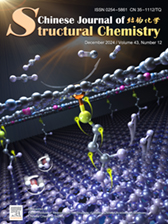
Cover Picture
Alkyl-linked TiO2@COF heterostructure facilitating photocatalytic CO2 reduction by targeted electron transport
Jiangqi Ning, Junhan Huang, Yuhang Liu, Yanlei Chen, Qing Niu, Qingqing Lin, Yajun He, Zheyuan Liu, Yan Yu, Liuyi Li* Submit a Manuscript
Alkyl-linked TiO2@COF heterostructure facilitating photocatalytic CO2 reduction by targeted electron transport
Jiangqi Ning, Junhan Huang, Yuhang Liu, Yanlei Chen, Qing Niu, Qingqing Lin, Yajun He, Zheyuan Liu, Yan Yu, Liuyi Li* Submit a Manuscript
Selective adsorption of organic dyes and iodine by a two-dimensional cobalt(II) metal-organic framework
Muhammad Riaz, Rakesh Kumar Gupta, Di Sun*, Mohammad Azam, Ping Cui*
Chin. J. Struct. Chem., 2024, 43: 100427. DOI: 10.1016/j.cjsc.2024.100427
December 15, 2024
Crystal structure; Metal-organic frameworks; Dyes adsorption; Iodine capture
ABSTRACT
The development of effective adsorbent materials for capturing organic dyes and iodine is crucial to reduce the environmental impact and ensure human health. In this context, a two-dimensional (2D) Co3-based metal-organic framework SDU-CP-7 (SDU = Shandong University, CP = coordination polymer) was rationally designed with 4-(4-carboxyphenyl)-1,2,4-triazole (Hcpt) and 2,4,6-tri(4-pyridinyl)-1,3,5-triazine (tpt) as organic linkers. The SDU-CP-7 was comprehensively characterized using single-crystal X-ray diffraction analysis, thermogravimetric analysis, Fourier transform infrared spectroscopy, Raman spectroscopy, powder X-ray diffraction analysis and UV-vis spectroscopy. Molecular docking was conducted to elucidate potential binding sites on SDU-CP-7 for effective interactions with RhB and ST. Featuring negatively charged surface and trigonal microporous channels, SDU-CP-7 exhibits excellent adsorption capacities for organic dyes (919.2 mg/g for Rhodamine B and 1565 mg/g for Safranine T) as well as iodine (563.0 mg/g in solution and 1100 mg/g in the vapor phase). The exceptional adsorption performance of SDU-CP-7 for cationic dyes can be ascribed to the electrostatic interaction facilitated by negatively charged zeta potential and the size-matching principle, whereas the pyridine active sites in channels significantly enhance the binding affinity for iodine. Moreover, SDU-CP-7 can serve as chromatographic column filters for the rapid adsorption and separation of dyes. The results demonstrate excellent selective adsorption performance of SDU-CP-7, highlighting its potential for environmental and industrial applications.







